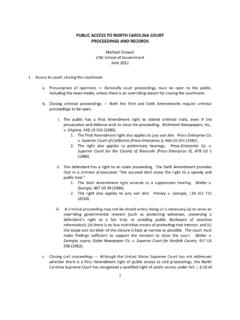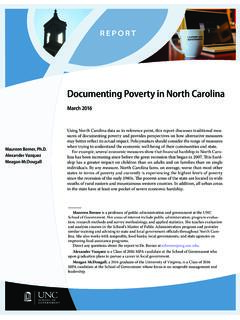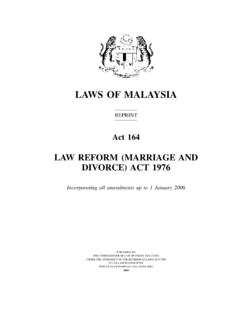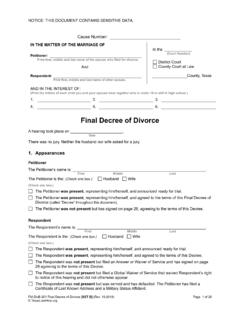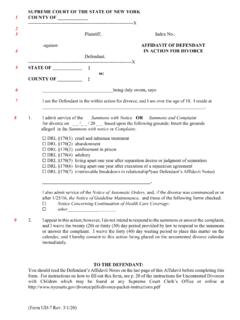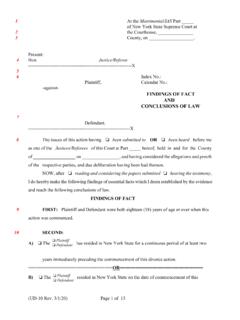Transcription of Chapter 6: Equitable Distribution
1 Chapter openingReplacement 9/20/2016I. Introduction and Overview .. 3A . Background .. 3B . Social Policy Considerations .. 3C . Constitutionality .. 4D . Right to Equitable Distribution (ED) .. 4II. Tasks of a Trial Judge .. 5A . Generally .. 5B . Classification .. 5C . Valuation .. 6D . Distribution .. 6E . When Parties Fail to Present Sufficient Evidence .. 6F . Discretion of the Trial Judge .. 7 III. Procedure .. 8A . Jurisdiction .. 8B . Venue .. 15C . Manner of Asserting Claim .. 16D . Necessary Parties .. 17E . No Right to a Jury Trial .. 18F . No Right to an Attorney .. 19G . Relationship of Equitable Distibution (ED) to Entry of divorce Judgment .. 19H . Relationship of Equitable Distribution (ED) to Common Law Property Rights .. 24I . Effect of Death of a Spouse on an Equitable Distribution (ED) Claim.
2 25J . Use of Reference Procedure .. 31K . Consideration of Alimony and Child Support .. 32L . Dismissal of an Equitable Distribution (ED) Claim .. 33M . Hearing .. 35N . Entry of Judgment .. 35O . Relief from an Equitable Distribution (ED) Judgment under G .S . 1A-1, Rule 60 .. 39P . Motion for New Trial under G .S . 1A-1, Rule 59 .. 43Q . Costs and Attorney Fees .. 43R . Applicability of G .S . 1A-1, Rule 68 (Offer of Judgment) to Equitable Distribution (ED) Actions .. 45IV. Pretrial Remedies, Procedures, and Protective Measures .. 45A . Pretrial Remedies and Protective Measures .. 45B . Pretrial Procedures .. 48V. Stipulations .. 53A . Generally .. 53B . If Stipulations Are Not Written, Requirements Set Out in McIntosh v. McIntosh Must Be Met .. 57C . Procedure to Set Aside a Stipulation .. 58VI. Agreements in Bar of Equitable Distribution (ED).
3 59A . Distribution of Marital and/or Divisible Property by Written Agreement .. 59B . Terms of the Agreement Will Control the Distribution of Property .. 60C . Procedure .. 63 VII. Effect of Bankruptcy .. 65A . Bankruptcy Reform Legislation .. 65B . Automatic Stay .. 65C . Property of the Bankruptcy Estate .. 67D . Discharge .. 68 VIII. Appeal .. 70A . Right to Take an Immediate Appeal .. 70B . Treatment of Findings of Fact and Conclusions of Law by an Appellate Court .. 72C . Standard of Review .. 73D . Effect of an Appeal on Jurisdiction .. 76E . Procedure on Remand .. 76 Chapter Folio 6 Chapter 6: Equitable DistributionPart 1. Equitable Distribution Overview and Procedure6 -1 TOCchapter openingReplacement 9/20/20166 2 ContentsIX. Enforcement of Judgment by Civil Contempt .. 78A . Civil Contempt Available for Enforcement .. 78B . Findings .. 81C.
4 Sanctions for Civil Contempt .. 81D . Award of Attorney Fees in a Contempt Proceeding to Enforce an Equitable Distribution (ED) Order .. 82E . Appeal of an Order for Civil Contempt .. 82F . Contempt After Appeal of an Equitable Distribution (ED) Order Is Filed .. 82G . Use of Criminal Contempt .. 83X. Enforcement of Distributive Award by Execution .. 83A . Enforcement as a Money Judgment .. 83chapter openingReplacement 9/20/20166 Part 1. Equitable Distribution Overview and Procedure I. Introduction and OverviewA. Background 1. Before 1981, North Carolina was a common law title jurisdiction with regard to prop-erty Distribution after divorce . Property was allocated after divorce to the party holding title thereto, a disposition that tended to reward the spouse directly responsible for its acquisition, while overlooking the contribution of the homemaking spouse. [White v. White, 312 770, 774, 324 829, 831 (1985).]
5 ]2. With the advent of no-fault divorce , dependent spouses lost the bargaining power of refusing to consent to a divorce .. The combination of no-fault divorce and a title only rule for property Distribution sometimes led to unconscionable results. [McLean v. McLean, 323 543, 549, 374 376, 380 (1988) (citations omitted). See also Leatherman v. Leatherman, 297 618, 256 793 (1979) (wife worked in home and in husband s closely held corporation for many years but could receive only one-half the marital home upon divorce under prevailing legal theories).] Pressure mounted for North Carolina to follow the lead of other states in adopting statutes based on commu-nity property or Equitable Distribution principles.. The General Assembly responded in 1981 by enacting An Act for Equitable Distribution of Marital Property, codified as 50-20, -21. [McLean v. McLean, 323 543, 549, 374 376, 380 (1988) (citations omitted).
6 See also Hill v. Hill, 229 App. 511, 518, 748 352, 358 (2013), and Simon v. Simon, 231 App. 76, 82, 753 475, 479 (2013) (both cases citing Friend-Novorska v. Novorska, 131 App. 508, 507 900 (1998), and both noting that one purpose of North Carolina s Equitable Distribution Act was to alleviate the unfairness of the title theory rule).] B. Social Policy Considerations1. Equitable Distribution reflects the idea that marriage is a partnership enterprise to which both spouses make vital contributions and which entitles the homemaker spouse to a share of the property acquired during the relationship. [White v. White, 312 770, 775, 324 829, 832 (1985).]2. Our Equitable Distribution statute, 50-20, was enacted in recognition of marriage as a partnership, economic and otherwise, to which both parties contribute either directly or indirectly. By enacting 50-20, our Legislature granted courts the power to con-sider factors other than legal title in distributing the marital assets upon the dissolution of the marriage thereby permitting courts to make an Equitable Distribution which effects a return to each party of that which he or she contributed to the marriage.
7 As we interpret it, the policy behind 50-20 is basically one of repayment of contribution. [Hinton v. Hinton, 70 App. 665, 668 69, 321 161, 163 (1984).]6-3 TOCchapter spreadsReplacement 9/20/20163. In other words, [t]he goal of Equitable Distribution is to allocate to divorcing spouses a fair share of the assets accumulated by the marital partnership.. The heart of the theory is that both spouses contribute to the economic circumstances of a marriage, whether directly by employment or indirectly by providing homemaker services. [Smith v. Smith, 314 80, 86, 331 682, 686 (1985) (citations omitted).]C. Constitutionality1. We believe 50-20 sets forth reasonably clear guidelines and definitions for courts to interpret and administer it uniformly and in accordance with the legislative intent. The United States Supreme Court has recognized that there are certain areas where, by the nature of the problems presented, legislatures simply cannot establish standards with great precision.
8 We feel the Distribution of marital property upon dissolution of a marriage is one such area.. We hold that North Carolina s Equitable Distribution stat-ute, 50-20, is not unconstitutionally vague. [Ellis v. Ellis, 68 App. 634, 636, 315 526, 527 28 (1984) (citations omitted).]2. The Equitable Distribution of property acquired before the effective date of the Equi-table Distribution Act violates neither equal protection nor due process rights under the North Carolina or United States Constitutions. [Armstrong v. Armstrong, 322 396, 368 595 (1988).]3. Retroactive application deprivation of vested interest in property. In Wilson v. Wilson, 73 App. 96, 325 668, review denied, 314 121, 332 490 (1985), the defendant filed her claim for Equitable Distribution before the 1983 amendment of the statutory definition of marital property. Before amendment, the statute referred to property acquired during the course of the marriage.
9 The 1983 amendment added the words and before the date of separation of the parties. The amendment was applicable to actions pending on Aug. 1, of the amended statute was upheld despite defendant s argument that the amendment was unconstitutional because it retroactively excluded certain property from being marital property and further that she had vested rights pursuant to 50-20(k) to particular marital property acquired after the date of separation. The court of appeals held that the statute does not create any vested rights in particular marital property; it create[s] a right to the Equitable Distribution of that property, whatever a court should determine that property is. [Wilson v. Wilson, 73 App. 96, 99, 325 668, 670 (emphasis in original), review denied, 314 121, 332 490 (1985).]D. Right to Equitable Distribution (ED)1. 50-20(k) provides that [t]he rights of the parties to an Equitable Distribution of mar-ital property and divisible property are a species of common ownership, the rights of the respective parties vesting at the time of the parties separation.
10 2. The vested right of ED does not create a property right in particular marital property, nor does the fact of separation create a lien on specific marital property in favor of the spouse. Rather, it only creates a right to an Equitable Distribution of that property, whatever the court should determine that property to be. [Perlow v. Perlow, 128 412 ( 1991); Wilson v. Wilson, 73 App. 96, 325 668, review denied, 314 121, 332 490 (1985).]6 4 Chapter 6: Equitable Distribution | Part 1 . Equitable Distribution Overview and Procedure TOCchapter spreadsReplacement 9/20/20163. ED is a method of property division upon divorce . Unlike the law in most community property states, ED has no effect on property rights during a marriage. There is no marital property unless married people separate and one requests ED. [See Tuwamo v. Tuwamo, 790 331 ( Ct. App. 2016).]II. Tasks of a Trial JudgeA. Generally1.



